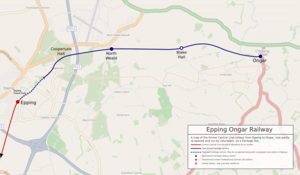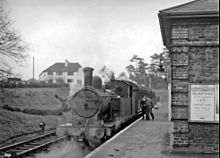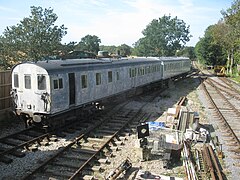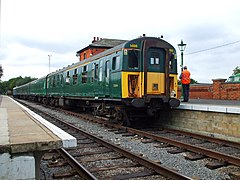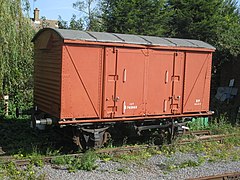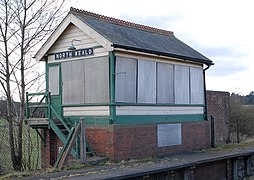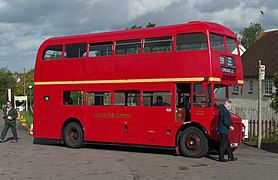Epping Ongar Railway
| Epping Ongar Railway | |||||||||||||||||||||||||||||||||
|---|---|---|---|---|---|---|---|---|---|---|---|---|---|---|---|---|---|---|---|---|---|---|---|---|---|---|---|---|---|---|---|---|---|
|
BR class 117 diesel multiple unit
| |||||||||||||||||||||||||||||||||
| Route length: | 10.4 km | ||||||||||||||||||||||||||||||||
| Gauge : | 1435 mm ( standard gauge ) | ||||||||||||||||||||||||||||||||
|
|||||||||||||||||||||||||||||||||
The Epping Ongar Railway is a heritage railway in the English county of Essex . It runs the 10.4 km long section between Epping and Ongar , which was originally built by the Great Eastern Railway and later used by the Central Line of the London Underground . The underground service was discontinued in 1994, but ten years later an association reactivated the line and ran a museum railroad with diesel multiple units . After a change of ownership, operations were suspended from 2007 in order to rehabilitate the route. Since the reopening in 2012, journeys with steam locomotives have also been offered.
Route history
The Great Eastern Railway (GER) opened the section from Loughton via Epping to Ongar on April 24, 1865 (the section south of it between Stratford and Loughton had been opened nine years earlier by the predecessor company Eastern Counties Railway ). While the Loughton – Epping section was expanded to two tracks in the 1890s, the Epping – Ongar section always remained a single track. At that time, 14 trains a day ran between London and Ongar. In 1923 GER was incorporated into the London and North Eastern Railway (LNER), which in turn became part of British Railways (BR) in 1948 .
During the Second World War , the LNER reduced the number of daily trips from London to Ongar to seven. In the second half of the 1940s, the London Passenger Transport Board implemented an ambitious investment program, the New Works Program . On September 25, 1949, the operation of BR was transferred to London Underground, with the trains of the Central Line initially only running to Epping. For the following eight years, steam-powered BR trains continued to run between Epping and Ongar. With the completion of electrification, underground trains ran to Ongar from November 18, 1957. The modest freight transport was still carried out with steam locomotives, the last freight train ran on April 18, 1966.
The electrification had been carried out as cheaply as possible. The voltage drop on the most distant section of the Central Line ( Blake Hall - Ongar) was too great to allow the usual eight-car trains to run. Another obstacle were the too short platforms. For this reason, passengers in Epping had to change to a shuttle train with two or three cars to get to Ongar. The steadily falling number of passengers led to the timetable being thinned out, as even at its peak in 1971 only 750 passengers used the route every day. In 1976 the siding in North Weald was removed and the signal box there , built in 1888, was decommissioned.
London Underground wanted to shut down the Epping – Ongar route entirely on October 6, 1980, but initially decided not to. Nevertheless, the barely used Blake Hall station was closed on October 31, 1981. The trains also only ran during rush hour on weekdays . In the 1990s, only about 80 passengers were using the route each day, each passenger causing a loss of seven pounds . Finally, on September 30, 1994, the heavy loss-making underground service was finally stopped.
Purchase and reopening
The company Pilot Developments (later Epping Ongar Railway Ltd. ) bought the disused track in 1998. The Ongar Railway Preservation Society had offered 325,000 pounds, but pilot Developments convinced London Underground after the deadline from accepting a slightly higher offer. The independent MP Martin Bell spoke of the "most controversial real estate deal in recent years in this constituency" and alluded to possible conflicts of interest among local politicians.
An association of volunteers, the Epping Ongar Railway Volunteer Society (EORVS), repaired the line and the building. On October 10, 2004, it began operating the museum with diesel railcars between Ongar and North Weald (on Sundays). A short time later the trains ran to Coopersale , a new stop not far from Epping. In connection with the building permit for a new housing estate in Ongar, the railway was sold three years later to a private owner who was determined to use steam trains as well. In December 2007, those responsible decided to suspend museum railway operations for the time being and to further improve the infrastructure in the meantime. Museum operations were resumed on May 25, 2012, exactly 150 years after the Great Eastern Railway was founded. During the 2012 Summer Olympics , most of which took place in nearby Stratford , the museum trains ran daily.
Museum railway operation
The Epping Ongar Railway operates its heritage railroad year round, usually on weekends and bank holidays . There are also trips on special occasions such as B. the "Santa Specials" before Christmas.
The operation is usually divided into two parts:
- From Ongar to North Weald: Train journeys by steam and diesel locomotives
- North Weald to Coopersale: Train journeys with diesel multiple units
In addition, historical buses run on three different lines in the area.
vehicles
Currently (2015) the fleet of the Epping Ongar Railway comprises 15 locomotives , including three steam locomotives , nine diesel locomotives , one diesel multiple unit , one diesel-electric multiple unit and one electric multiple unit . In addition, there are various rail cars , a rail mail car , two brake cars , ten freight cars and four special vehicles.
photos
Class 5101 steam locomotive ( Great Western Railway )
Class 31 diesel locomotive ( British Railways )
Routemaster double-decker bus
Web links
Individual evidence
- ^ A b c A brief history of the Epping Ongar Railway. Epping Ongar Railway, 2015, archived from the original on April 22, 2012 ; accessed on September 9, 2015 .
- ↑ Epping to Ongar railway reopens: steam, archive photos, Blake Hall and Sham 69. Urban75, April 11, 2012, accessed on September 9, 2015 (English).
- ↑ a b There's life in the old track yet. The Independent , July 9, 1995, accessed September 9, 2015 .
- ↑ North Weald Signal Box. Epping Ongar Railway, 2015, archived from the original on May 3, 2015 ; accessed on September 9, 2015 .
- ^ Blake Hall poster. abandonedstations.org, accessed September 9, 2015 .
- ↑ a b Brentwood: Candidates in rail row. Clacton and Frinton Gazette May 23, 2001, archived from the original August 10, 2007 ; accessed on September 9, 2015 .
- ^ Train line could be back on track. Ongar Guardian, February 17, 2004, accessed September 9, 2015 .
- ^ Epping Ongar Railway announces the resumption of passenger services. Epping Ongar Railway, March 30, 2012, archived from the original January 9, 2016 ; accessed on September 9, 2015 .
- ↑ Stock list. Epping Ongar Railway, 2015, archived from the original on August 31, 2015 ; accessed on September 9, 2015 .

